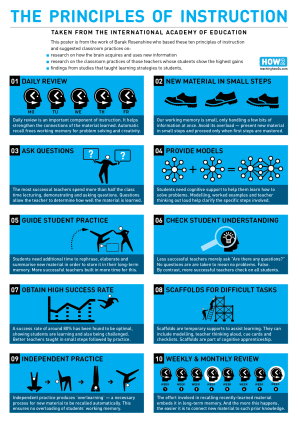Research and development focus
The focus of the research is reducing low-level disruption through effective teacher presence in the classroom. Features of low-level disruption are stated by Ofsted (2014) as any distracting behaviour which does not threaten the safety of students but includes actions such as:
- Talking unnecessarily or chatting
- Calling out without permission,
- Being slow to start work or follow instructions
- Showing a lack of respect for each other and staff
- Not bringing the right equipment.
It is argued that all behaviour is linked to emotions, and thus as teachers our jobs are to develop emotional intelligence in students in order for them to achieve the best academic and personal outcomes (Kilby, 2018). The way to do this is (a) build effective relationships between students and teacher (b) set clear expectations of behaviour using sanctions and rewards and (c) maintaining a physical ‘presence’ in the classroom in three “powerful places”; at the door, at the front of the class (in ‘your’ space), and at the back of the class; in ‘their’ space (Wirth, 2019).
From our group discussions we noted that as there was a school-wide procedure of “meet-and-greet” students are usually engaged at the beginning of the lessons. However, low-level disruption in the form of chatter, or passivity usually starts when students are seated at their desks.
Literature Review
The article “Behaviour: Rules vs Expectations” questions whether the emphasis on sanctions and rewards is the best response to managing challenging behaviour and ensuring the best outcomes for students, particularly when it could be counterproductive to “developing well-rounded, intrinsically driven individuals”.
The article by Stafford (2018) explores the underlying causes of challenging behaviour, whether this is considered a mental health problem, and looks at other underlying causes, for example, reading age, depression or ADHD. Stafford (2018) argues for the need of diagnosis and a whole-school approach to mental health and well-being rather than focusing on sanctions.
Wirth (2019) states the importance of space in establishing authority in the classroom. The key spots are stated to be at the (a) class door where the teacher should greet and welcome each student, (b) in front of the whiteboard, which is the teacher’s “power spot” and lastly (c) the back wall of the classroom which is “their” space. Wirth suggests that the more “expert” teachers use these three spots strategically to establish classroom behaviour.
 |
| The front of the classroom is the teacher's 'power spot', yet not always the best place to position oneself. |
Intervention
I am to focus on the use of these three “power spots” with a middle ability year 8 class that can be unsettled at certain points within the lesson. I already use the space at the door to welcome students and stand in front of the whiteboard to teach, so I will focus on the impact of being in “their” space against the back wall to explore the impact of this on pupil behaviour.
I will practice using these three places of power over a six week period and evaluate each lesson for low-level disruption by keeping a learning log. I will then compare the first lesson with the last lesson to see if there have been any improvement in pupil behaviour since the beginning of the intervention.
I will also compare the evaluations to a lesson reflection I have done with this class before beginning the intervention.
 |
| A teacher occupying the students space. |
Implementation and Impact
The class is made up mainly of boys who have a close friendship group and they can get unsettled quite easily. The meet and greet at the class door was already being used prior to this study. This meant lessons started off well however during the course of the lesson some low-level disruption (LLD) would appear.
For the first lesson in the research period I conducted my lesson as usual. I was teaching mainly at the front of the class and only went towards the back of the classroom when checking on progress during individual work. I did not use the back wall when teaching. This was to make this lesson a control to compare with the intervention.
From evaluating the first lesson I found that students would lose focus when I was standing at the front constantly during whole-class teaching. I noted that “after ten minutes two tables at the back started to whisper to each other. I addressed them with a question and this re-focused them. Went to check on them after to check they were focused.”
For the next five lessons I tried to use the back wall as the “third space of power” when whole-class teaching. About five minutes into verbal questioning I would travel to the back of the class and target a student with a question whilst standing at the back wall. This engaged students in the back two rows. However some students were distracted by the movement as they were not used to seeing this. I observed this in the learning log:
“...ZA started to snigger and look at ON as I approached the back wall. ZA made a response like “what’s going on?” as he found the situation humorous.” Similar reactions did occur in the second lesson however in further lessons they had become more accustomed to movement around the classroom during targeted questioning. In the last lesson the students in the back rows seemed to be more engaged during the whole lesson. I reflected in the learning log that:
“ON started to raise hands within the first few minutes of the feedback session and ZA was repeatedly raising hand to join in with the discussion. However MR lost focus and as he could not see me at the back started to whisper across the table.” The student MA was sitting in the front row. I believe he may have begun to become disengaged as I was no longer as present at the front of the classroom where he sits. This reflection shows that the movement of the teacher around the room can be a useful tool in keeping students engaged. However the movement may need to be varied and frequent to keep all students engaged at the same time.
Further research
Further research could explore the effect of time on the impact of teacher presence at different spaces within the classroom. The presence of the three spaces may be most effective at different times in the lessons as well. For example, during targeted questioning it could be insightful to explore the length of time a teacher should spend at each space of power and how this affects engaged of all pupils in the classroom.
Recommendations
- For effective teaching and engagement of all pupils in lessons teachers should think carefully about their positioning in the classroom.
- Teachers should avoid limiting their presence to one part of the classroom as the presence of the teacher can help to keep students engaged throughout the lesson.
- Movement in the classroom should not become a distracting factor which then leads to lower level disrption.
References
- Ofsted, 2014, “Below the radar: low-level disruption in the country’s classroom”
- Wirth J, 30th Jan 2019, “The death of teaching: Gone in 420 Seconds”, SecEd.
- Kilby R, 10th Oct 2018, “Behaviour: Rules Vs Expectations”, SecEd.
- Stafford C, 26th Sep 2018, “The underlying causes of challenging behaviour”, SecEd.
You can follow Mqliza on Twitter
@MqlizaS







